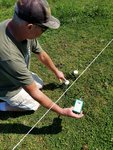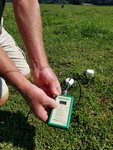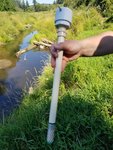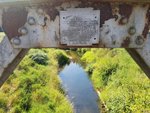



Western Washington may be infamous for its persistent rainfall, but once summer rolls around and the great faucet in the sky shuts off, things can get awfully prickly around the farm. That annual drought coincides with the region’s prime agricultural growing season and forces many farmers to suck water right out of the nearest river in order to keep green things growing and the bottom line in the black.
That long standing irrigation practice has a few notable drawbacks though.
One problem throughout the years has been the propensity for small fry fish to get sucked right out of the river and up into the irrigation pipes. That unintentional intake can be detrimental to equipment and fatal for fish.
In recent years, low flows in area rivers have regularly served to compound that problem by condensing the fish and limiting their travel. What’s more, as water levels drop off junior water rights holders can have their rights shut off and senior rights holders harbour deep fears of being asked to limit, or even halt, their usage in order to keep water in the river.
As pressures on water rights increase, so too are government protections for some threatened fish species. That confluence of natural resource concerns has the capacity to put farmers in dire straits, which is exactly what happened in 2015 when at least 93 junior water rights holders in the Chehalis Basin were issued orders to cease drawing water during a particularly stubborn summer.
It’s with that stark reality in mind that the Lewis County Conservation District has embarked on a mission to improve area irrigation practices.
In Adna, farmer Bill Reisinger describes his 275-acre slice of the Chehalis River basin as a sort of “banana belt”. He says precious summertime precipitation skirts to the north and south and regularly leaves his fields high and dry despite being planted between both Bunker Creek and the mainstem of the Chehalis River.
“Back when we were growing corn and peas I would have kissed the ground and ate dirt for a summer rain shower,” said Reisinger.
These days Reisinger sticks primarily to grain crops like wheat, oats and barley, along with pasture grasses and alfalfa that he sells at market. Thanks to highly valuable senior water rights that date back to the early 20th century he is able to draw water from the Chehalis River for irrigation to keep those crops growing. Reisinger says, depending on the weather, he typically irrigates about seven days a week between May and late September using a pump that draws about 400 gallons of water per minute from the river. It’s enough to run about 75 sprinklers and keep his green acres green.
A fisherman himself, Reisinger would love to have dependable runs of fish behind his farm again. He waxes romantic on days when sea-run cutthroat trout that were ready to fight were plentiful in the river. He laments that these days he doesn’t see many salted fish making it back to his stretch of the river. With his love of fish and farming at a crossroads, Reisinger decided to sign up for the Conservation District’s two-tiered irrigation program.
“We write irrigation plans for water management and give them moisture meters to help them better manage the soil moisture. We are also installing fish screens to prevent fish from being sucked into the pumps,” explained Kelly Verd, special projects coordinator for the Lewis County Conservation District.
Verd noted that the Conservation District received its first funding for the project in 2015 through a partnership between the Rose Foundation, U.S. Fish and Wildlife and the Washington Department of Ecology. Those funds cover irrigation improvements for farmers in Lewis, Grays Harbor or Cowlitz counties.
“To date we have completed 41 plans and there are more in process. These plans cover approximately 2,300 acres of irrigated farmland. The farms we have worked with include cow dairies, a sheep dairy, beef operations, hay farms, and crop farms,” said Verd.
Verd added that along Bunker Creek alone three large farms she calls “the major irrigators” are already participating in the program. She noted that the project has also included five classes with information ranging from how to keep water rights, how to irrigate during a drought, putting water in trust, monitoring soil moisture, and understanding water holding capacity.
“Mainly, this is a fish project,” said Verd, who says that the screens are intended to protect salmon and steelhead smolts, along with species like lamprey, trout and sculpin.
“I have funds to complete plans until December. We have installed 12 fish screens and have applied for a grant to install 15 more,” added Verd.
Despite the dueling pastoral and piscatorial promise of the irrigation program, Verd admitted that she has received pushback from some farmers, especially during her early efforts. She said the design of the fish screen made some farmers nervous because they believed it would easily become clogged with debris.
However, Verd pointed out that the fish screens come with a “self-cleaning” design that uses rotating streams of water from inside the head to keep the screen clear.
Reisinger joined the improved irrigation effort this spring and he was overflowing with positive reviews for the program during a tour of his farm last week.
“I’m really happy with it, bottom line,” said Reisinger, who noted that river flows are uncharacteristically low this summer. “The water did me a lot of good this year. You can see the rest of the county is all burnt up.”
He noted that with traditional pump setups the water was sucked in at a higher velocity due to the smaller diameter of the head. That concentrated vacuum would collect river debris and cause a deep hole to develop in the river bottom beneath the pump intake, both of which restricted flow to his fields. Reisinger said that regular chores around the farm used to include diving underwater to clean of the submerged valve head. He insists the job wasn’t as fun as it sounds and the problem was worst in late summer when flows are lowest and the leaves begin to fall.
“It’s just one more of the tools that we’re trying to add,” said Reisinger. “It’s actually going to help some fish. The equipment works as good as the old stuff, and I don’t have to go in there and clean that foot valve once a week.”
Maynard Mallonee is another pleased participant in the irrigation program. His 125-acre organic dairy farm is located along the South Fork of the Chehalis River up the Boistfort Valley and he irrigates his pastures for hay and grazing. Like Reisinger down on the main channel, Mallonee has also spent years going rounds with his clogged valve heads – That is until he began using the fish screen provided by the Conservation District this spring.
“Before I’d suck up pieces of rock, dirt, fish, grass, all sorts of stuff,” said Mallonee, as he macheted his way down a blackberry choked path to the river. “With this you don’t have to clean your nozzles, which is a pain in the butt!”
Interestingly, the improved river pump setup, and its associated benefits for fish and the toils of farmers, was not the primary inspiration for Mallonee to sign up for the program. Instead, he wanted to get his hands on an irrigation meter so he could further hone in his rotational grazing and watering practices.
“That’s one thing we’re trying to do is get farmers more efficient irrigation equipment but there’s just not a lot of funding for that,” explained Verd
The metering device, which looks a like capped PVC-pipe, is buried beneath the soil with just its information dispensing head left above ground so farmers can hook up to it for periodic reports on how much water has saturated certain depths in the field. For common pasture grasses the meters take readings at depths of one and two feet. Since the root structure typically doesn’t reach beyond that, Verd noted any water at those depths would be wasted.
This year Mollennee has been able to get six rotations on his patchwork of pasture plots. He says that he has found its better to start irrigating early in season, before the grasses begin to show any yellow, in order to keep his fields in prime condition for his pampered bovines.
“It may not seem like a big deal to irrigate your pasture but if you’re not watering you might only get two, three tons of hay per acre. But if you water you could get upward of six tons, which is a big difference for your farm,” explained Verd.
Standing next to a sunbaked cowpie and a lush clump of tall soft fescue grass Mallonee surveyed his swaths of green and agreed with Verd’s assessment. He even noted the global implications of freshwater usage, detailing how in recent years the prime grass and alfalfa hay crops of the Northwest have been hoarded in bulk shipments to buyers in Asian markets.
“They say they aren’t really buying hay. They are buying water,” said Mollenee.